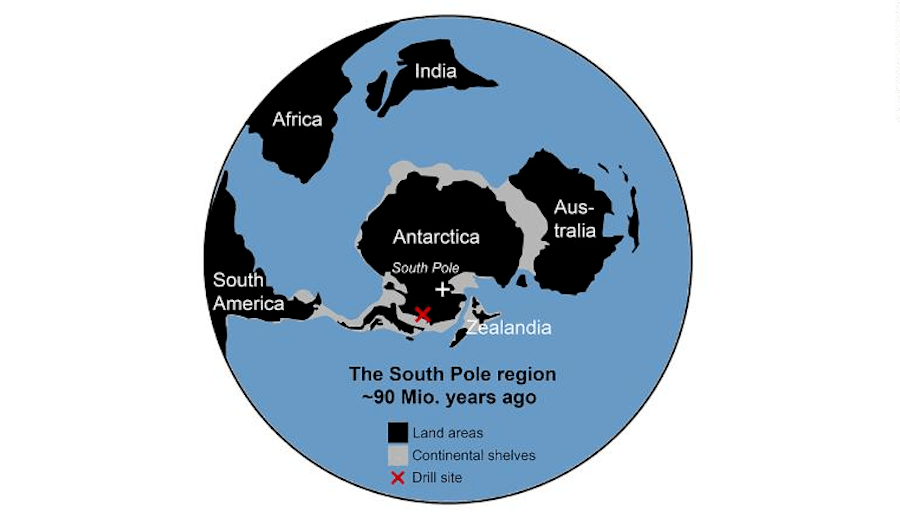“Unearthed Secrets: What a 90-Million-Year-Old Antarctic Rainforest Reveals About Earth’s Lost Climate”
Imagine Antarctica—today’s icy wilderness—teeming with life, warmth, and, believe it or not, exotic rainforests! It sounds like the backdrop for a sequel to Jurassic Park, doesn’t it? But here’s the kicker: evidence from ancient soil samples reveals that this frozen region was once a flourishing rainforest during the Cretaceous Period. Researchers unearthed mind-boggling findings from sediment core samples taken near the Pine Island and Thwaites glaciers, uncovering forest soil, pollen, and even root structures that are 90 million years old. It’s like unlocking a time capsule of Earth’s distant history! So, what exactly was going on down there when dinosaurs roamed and the world was a tropical paradise? Buckle up, because the revelation of a verdant, swampy Antarctica challenges everything we thought we knew about the planet’s climatic past! LEARN MORE.
Evidence found in an ancient soil sample indicates that during the Cretaceous Period, Antarctica was home to a thriving rainforest on its iceless terrain.

Alfred Wegener InstituteThe new study was based on sediment core samples taken in 2017 near the Pine Island and Thwaites glaciers.
Though the Earth was much warmer when dinosaurs roamed 90 million years ago, it’s hard to imagine the South Pole as a luscious, vibrant environment. According to CNN, however, new evidence suggests that Antarctica was once a swampy rainforest.
Between February and March 2017, researchers drilled into the seafloor near West Antarctica’s Amundsen Sea. More precisely, the sediment core sample was taken near the Pine Island and Thwaites glaciers. The results of the subsequent CT scans came as an utter shock.
Published in Nature, the scans revealed samples of forest soil, pollen, spores, and root systems. These were so well preserved that Alfred Wegener Institute experts could identify cell structures, including pollen from the first flourishing plants found this close to the South Pole.
“During the initial shipboard assessments, the unusual coloration of the sediment layer quickly caught our attention; it clearly differed from the layers above it,” said geologist and lead author of the study Johann Klages.
“We had found a layer originally formed on land, not in the ocean.”
After dating the soil, researchers were stunned to find it was 90 million years old.

Alfred Wegener InstituteTina Van De Flierdt and Johann Klages were stunned at the information revealed in this ancient sediment from 90 million years ago.
The warmest period for Earth in the last 140 million years was the mid-Cretaceous era, between 80 million and 115 million years ago. Sea levels were 558 feet higher than they are now, with surface temperatures reaching up to 95 degrees Fahrenheit in the more tropical regions.
Up until now, however, no evidence this far south has been collected regarding Antarctica’s conditions between 83 million and 93 million years ago. This is officially the southernmost sample of soil regarding that particular location and period of time.
“The preservation of this 90-million-year-old forest is exceptional, but even more surprising is the world it reveals,” said Tina van de Flierdt, co-author of the study and professor in the Imperial College London’s Department of Earth Science and Engineering.
“Even during months of darkness, swampy temperate rainforests were able to grow close to the South Pole, revealing an even warmer climate than we expected.”

Alfred Wegener InstituteThis map shows the exact drill site the samples were taken from, as well as the formation of continents during the Cretaceous Period.
The discovery indicates that Antarctica wasn’t always covered in ice caps. Instead, the region was warm, covered in flora, and essentially your typical, moist rainforest. In terms of climate studies, sediment cores are exceptional.
They’re practically time capsules to assess average temperatures, rainfall, and vegetation.
“To get a better idea of what the climate was like in this warmest phase of the Cretaceous, we first assessed the climatic conditions under which the plants’ modern descendants live,” said Klages.
According to the research, the average daytime temperature was 53 degrees Fahrenheit. That might not seem hot and humid, but contrasted with current daytime temperatures sitting between negative 76 degrees and 14 degrees Fahrenheit, the difference is stark.
River and swamp temperatures, meanwhile, hovered around 68 degrees, while the region’s summer temperatures were estimated to have been around 66 degrees.
Researchers believe precipitation totaled around 97 inches per year — roughly equivalent to yearly rainfall in Wales today.

Alfred Wegener InstituteThe Alfred Wegener Institute specializes in polar research like that of Klages’ and van der Flierdt’s. Pictured here is its research vessel the Polarstern (or polar star).
Though the researchers were delighted with their discovery, they still had to account for Antarctica’s four-month polar night. How did Antarctica sustain these swampy conditions across four sunless months?



















